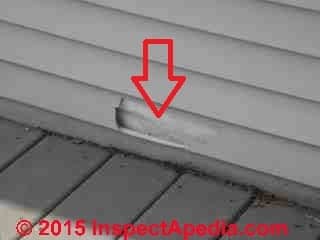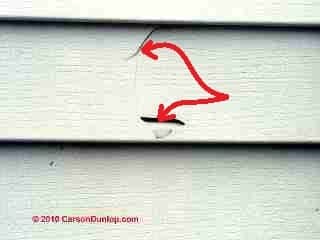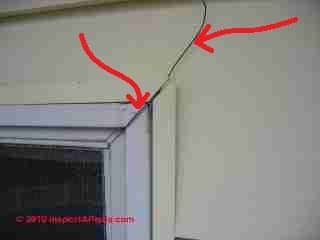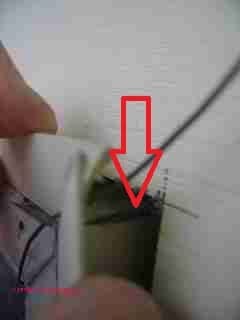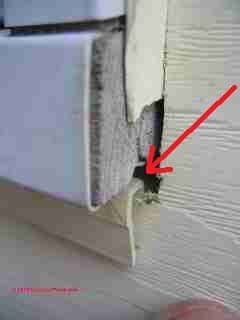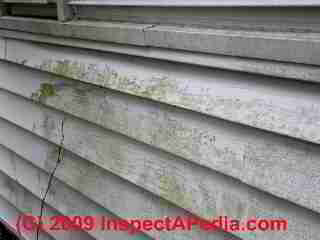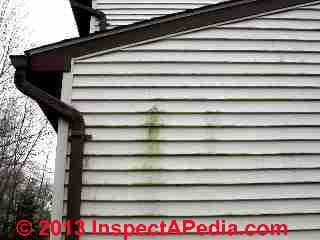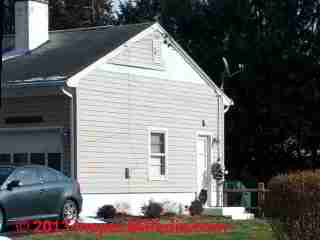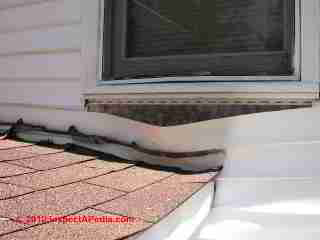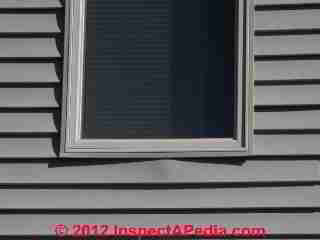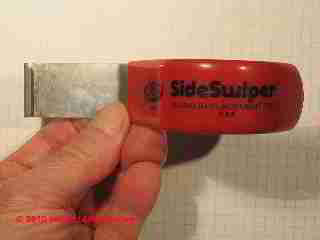 Vinyl Siding Inspection Checklist
Vinyl Siding Inspection Checklist
&
Vinyl Siding Repair Methods
- POST a QUESTION or COMMENT about Vinyl Siding on Buildings, Installation, Inspection Methods, Defects, Diagnosis & Repair
Vinyl siding defect recognition & diagnosis:
Improper installation details of vinyl siding or of vinyl siding F or J channel trim or corner moldings can cause or aggravate building leaks and even invite insect pests and structural damage.
This article discusses common defects observed in vinyl exterior building siding, such as buckling, splitting, cracks, odors, and questions about the need for a vapor barrier behind vinyl siding and over building sheathing. Included are comments from several recognized building inspection and construction authorities.
Our page top photo shows wrinkled vinyl siding - often caused by heat exposure such as from a BBQ Grill - but in this location the pattern and size of the damage made us suspect that there was another cause.
InspectAPedia tolerates no conflicts of interest. We have no relationship with advertisers, products, or services discussed at this website.
- Daniel Friedman, Publisher/Editor/Author - See WHO ARE WE?
Inspect Vinyl Siding for Damage: Examples of Bad Installation, Cracks, Leaks & Other Damage to Vinyl Siding
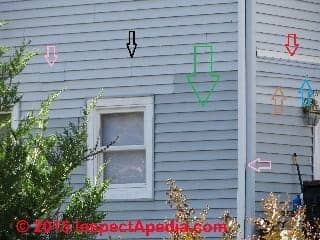
[Click to enlarge any image]
While some vinyl siding on the home shown above has been replaced (darker siding at green arrow) this was one of the worst vinyl siding installation jobs I've seen.
At this New York home the siding has at some locations been installed using scraps (pink arrow), with gaps (black arrow), with lower corner trim on the outside rather than inside of the upper corner trim segment (leaky at pink arrow), buckling (tan arrow), with un-even, overlapped courses (blue arrow), perhaps where the siding was installed below a now-removed porch roof that has been left poorly-flashed as a possible wall leak (red arrow).
This article discusses vinyl siding inspection points, defects, and repair procedures.
Article Series Contents
- VINYL SIDING INSPECTION & REPAIR
- SIDING CLEARANCE TO GROUND - Insect Risk, drainage & required clearances between siding and the ground
- VINYL SIDING BUCKLED WARPED - separate article
- VINYL SIDING GAPS, HOLES, CRACKS at Vinyl Window Trim
- VINYL SIDING IMPACT DAMAGE, CRACKS, HOLES
- VINYL SIDING J-CHANNEL MISTAKES Cause Costly Building Damage
- VINYL SIDING LEAKS - separate article - diagnose & repair of vinyl or other building siding leaks
- VINYL SIDING LOOSE, BLOW-OFFS, Fall-Offs & Nailing Defects
- VINYL SIDING ODORS / Plastic Odors, Emissions, Health Information
- VINYL SIDING HOOK to REMOVE & REPLACE
- VINYL SIDING INSTALLATION MANUALS
- VINYL SIDING STAINS - separate article on Algae, Fungus ("Mildew"), Artillery Fungus, Smoke, Dirt, Leaks on siding
- VAPOR BARRIERS, VINYL SIDING - separate article
Impact Damage, Cracks, & Holes in Vinyl Siding
Most of the vinyl siding problems we see appear to be due to poor installation details, though on occasion we see cracks and breaks that may be blamed on older, more brittle vinyl products.
Our photo (above) demonstrates impact damage to vinyl siding, in this case just above the floor of an outside deck.
Our second vinyl siding damage (below, courtesy of Carson Dunlop Associates ) demonstrates an impact damage even to siding that made both a hole and a crack in the wall covering.
With (often older-generation) more brittle vinyl wall siding products we often find impact damage and holes caused by stones kicked-up against the wall by a lawn mower or weed-wacker.
Vinyl Siding Gaps & Holes Caulked; Cracks at Vinyl Window Trim
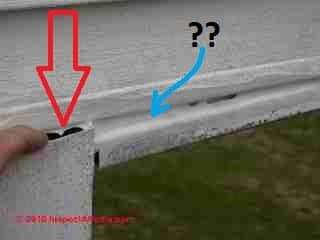 ...
...
Our vinyl siding caulk photo (above) shows a combination of improper trim installation, building leaks, caulk where it is not helping, and even the caulk was so sloppily applied that it didn't seal anything.
Our photo above shows cracking vinyl siding above a window corner - a bad place for a leak that can lead to building water entry, window damage, and even hidden mold.
Improper J-Channel in Vinyl Siding Cause Costly Building Damage
One of the most common vinyl siding installation mistakes (also found on aluminum sided buildings) is the improper cut and trim of the ends of horizontal J-channel used above windows and doors (shown at below-left), or improper termination of the bottoms of J-channel used along the sides of windows or doors (shown at below right).
A simple error such as short-trimming of the J-channel and failure to provide proper water-directing bends can send water behind the J-channel and into the building wall and structure.
In our photo above it looks like really sloppy J-channel work during siding installation, leaving a leak at the window sill.
The required tab extension on the horizontal or upper J-channel is missing entirely, allowing J-channel rainwater to flow down behind the vertical J-channel along the window side.
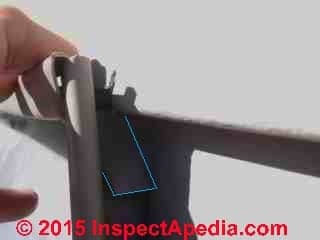 In our vinyl siding J-channel photo above it appears as if the window-top horizontal J-channel end cut tab was correctly cut and bent over the outside of the vertical J-channel running along the window side.
In our vinyl siding J-channel photo above it appears as if the window-top horizontal J-channel end cut tab was correctly cut and bent over the outside of the vertical J-channel running along the window side.
A reader provided this detail during investigation of leaky vinyl siding that is illustrated and discussed
at SIDING LEAK DIAGNOSIS & REPAIR.
[Click to enlarge any image]
Watch out: J-Channel errors can rot windows and doors: Our photo of improperly-cut J-channel trim around a window (above right) shows a more serious problem than may be immediately apparent.
In Spackenkill, Poughkeepsie, NY we found an entire neighborhood of homes in which nearly all of the windows were rotted beyond repair due to this error.
Wind-blown rain sent inside the J-channel trim and into the window structure was the problem caused because the installer didn't follow the manufacturer's instructions. Properly the top J-channel is trimmed to include a tab bent over the vertical J-channel to route water outside, not inside the trim.
See FIGURE 1-25 in Best Construction Practices for details, and return here using your browser's "Back" button.
Here is what the Vinyl Siding Institute Advises about Installing J-Channel
J-channel is used around windows and doors to receive the siding. Follow the steps below when applying trim.
- Cut and bend the tab of the top piece of J-channel down to provide flashing over the side J-channel. [This instruction pertains to J-channel run above windows and doors. Omission of this detail is a very common mistake that leads to leaks in and around windows - Ed.]
- Fold the bottom end of the side piece of J-channel inward at the bottom of the window, to fit over the existing J-channel to prevent water from entering under the sill.
- Cut the side J-channel members longer than the height of the window or door, and notch the channel at the top. Figure 33 [in the original document]. J-channel J-channel Window Head Flashing Figure 34.23
- Miter cut the free flange at a 45° angle and bend the tab down to provide flashing over the
side members (Fig. 34) [in the original document].
A similar miter and tab may be provided at the bottom of the window, depending on the sill’s condition. The J-channel should fit snug to the window. - The Vinyl Siding Institute, Website: http://www.vinylsiding.org/Email: vsi@vinylsiding.org, - retrieved 9 Feb 2015, original source: http://www.vinylsiding.org/wp-content/uploads/2015/01/I1_Vinyl_Siding_Installation_Manual_English.pdf
See VINYL SIDING INSTALLATION for details.
See DIVERTER KICK-OUT FLASHING that can stop leaks at the roof eaves if the bottom open end of J-channel is sending water behind the gutter end-cap and down the building wall
Also see PEEL & STICK FLASHING MEMBRANES for products useful to seal around windows and doors before installing siding
Stains on Vinyl Siding
Details about stains on vinyl siding are now found in a separate article
Common sources of stains on vinyl siding include formation of algae, fungus, lichens, dirt accumulation on damp surfaces, rain splash-up soil, even smoke from nearby barbecues or fires.
More about building wall stains can also be found in these companion articles:
- STAINS on & in BUILDINGS, CAUSES & CURES
- STAIN DIAGNOSIS on BUILDING EXTERIORS
- STAINS on SANDSTONE, DIAGNOSE & CURE
- STAINS on STONE, STUCCO DIAGNOSE & CURE
Leaks From Vinyl Siding Bottom Edges; Breaks or Cracks in Vinyl Siding
Details about the causes of & cures for leaks in building siding are now
at SIDING LEAK DIAGNOSIS & REPAIR
Vinyl Siding is Not Waterproof
Watch out: vinyl siding used on building exteriors is not nor is it meant to be a waterproof barrier. While the actual face of vinyl siding is waterproof, a vinyl sided building wall is by no means waterproof.
Openings at the lap joints of vinyl siding sections as well as drain openings provided along the bottom edge of most vinyl siding products let the wall system breathe and allow wind-blown rain that may enter the siding to drain out of it as well.
Loose Vinyl Siding: Blow-Offs, Fall-Offs & Nailing Defects
Below our photographs show what happens to loose, poorly-secured vinyl siding on a home. These two loose siding pictures were taken just about a year apart. We had watched the loose buckling siding on this Poughkeepsie NY home for some time.
Finally after a windstorm much of the gable end siding has simply been lost completely.
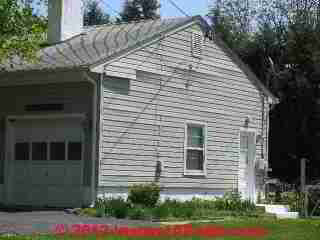
Below are additional examples of poorly-attached siding (below left) and siding that was literally pulled off of the building when an adjoining structure itself collapsed.
The consequences of the failure at right were more serious than met the eye: this wide opening into the building wall allowed rain to soak the wall interior, leading to costly mold, rot, and insect damage to the structure.
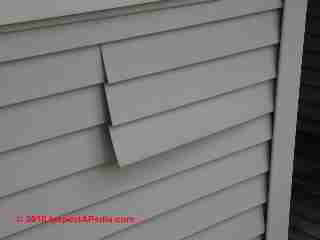
In our photo at above left demonstrates a loose siding panel that is inviting more serious wind damage.
Our second photo below demonstrates a combination of poor siding installation, improper lower-roof flashing, a home that sat for months unattended while wind, rain, and snow penetrated the structure.
These are almost certainly construction and installation defects, not product defects.
Causes & Cures for Damaged Vinyl Siding: Bent, Buckled, Rippled or Sagging Vinyl Siding
Vinyl siding that buckles due to improper nailing (photo shown above left) is is not normally extremely wrinkled, and will be more wavy across longer horizontal runs of surface.
A Complete Guide to Causes of Rippled, Buckled, Bent Vinyl Siding is at:
- VINYL SIDING BUCKLED WARPED - caused of buckled or warped vinyl siding
Watch out: buckling vinyl siding at the bottom of a wall may indicate hidden structural damage or insect pest damage. Details are in the article cited above.
Detailed specifications for hanging vinyl siding to avoid buckling and blow-offs are found in this separate article:
- VINYL SIDING INSTALLATION - includes these sub-topics:
Don't Bury Siding at Wall Bottoms, Direct Water Away, Avoid Insect & Rot Risks
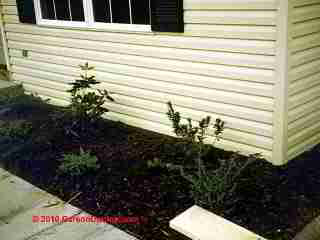 As Carson Dunlop Associates' photograph vinyl siding photo shows (below left), bringing vinyl siding down to ground contact or even below ground may please the architect or home owner's sense of aesthetics, but it is an engraved invitation to wood destroying insects to attack the structure.
As Carson Dunlop Associates' photograph vinyl siding photo shows (below left), bringing vinyl siding down to ground contact or even below ground may please the architect or home owner's sense of aesthetics, but it is an engraved invitation to wood destroying insects to attack the structure.
Carson Dunlop Associates are a Toronto home inspection, report writing tool and education company. Photo used with permission.
We like to see 6-8" of clear foundation wall between the bottom of wall siding and the top of the ground surface.
Adding mulch as was done in the yellow-vinyl-sided house, increases the invitation to termites.
In addition, this home's mulch bed conspires with a water trap formed by the sidewalk and excavation to contain the mulch so as to trap water against the foundation, inviting water entry into the building's basement or crawl space.
Our next photo (below) shows siding buried several feet underground along the building's gable-end.
The fact that the surface is sloped is not sufficient to avoid risk of insect attack on this home.
To correct this buried siding problem will require excavation along the building wall and probably construction of a retaining wall along with steps to be sure that surface runoff from the up-slope side of the building is directed away from the home and not along the building's side-wall.
See SIDING CLEARANCE TO GROUND for details.
Vinyl Siding / Plastic Odors, Emissions, Health Information
Watch out: Information about vinyl products (not just siding) that may produce odors or have other health risks, fire risks, and environmental concerns that can be found at
Remove & Re-Install Vinyl Siding: use a Siding Hook
[Click to enlarge any image]
Shown above is a siding hook, also referred to in some manuals as a zip tool.
Steve Bliss points out at VINYL SIDING LOCK & NAIL FLANGES that all vinyl siding panels have a locking
tab at the bottom of each panel that snaps over the top tab
of the panel below.
Watch out: trying to tear off vinyl siding without unhooking the lower edge (buttock) of each siding course from the course below risks damaging more siding courses and increasing the cost of repair or replacement of the wall cladding.
In fact, without a siding replacement tool such as Malco's Side Swiper SRT1 shown in our photo above, even if you can tear off the siding, re-hooking the bottom edge of the new siding section to the top of the course below can be almost impossible.
See details of how to use this tool
at VINYL SIDING HOOK to REMOVE & REPLACE
How to Remove & Replace Thick, Non-flexible Vinyl or Polycarbonate Siding Panels
CertainTeed and other manufacturers note that when removing thicker non-flexible vinyl or polycarbonate siding panels such as that company's Cedar Impressions Panel, to remove the old panels you will need to use a wood chisel to locate the locking tab of the old panel and to literally break it off.
The siding zip tool shown above won't work as the thicker plastic panels are not flexible enough to simply pull down and un-hook.
The company provides a panel replacement kit that includes new cam clip and snap rivet fasteners to hold the replacement Cedar Impressions Panel in place. Or alternatively, colored trim nails can be used to secure the new panel in place.
Download Free Vinyl Siding Installation Manuals
Your local vinyl siding supplier or building supplier will be happy to give you the vinyl siding installation manual for the specific product you are purchasing, as everyone involved has an interest in a proper vinyl siding installation. If your supplier is out of manuals for their product just give the manufacturer a call or check their website for a down-loadable vinyl siding manual. Here are some sources of vinyl siding installation guides:
- Beck, David H., Robert D. Shaw, and David J. Stucky. "Temperature-expansion indicator for siding panels." U.S. Patent 6,939,036, issued September 6, 2005.
Abstract:
A temperature indicator for a siding panel senses panel temperature and indicates on a graphic scale the corresponding effect of thermal expansion over differences in temperature.
The temperature indicator can be various forms of contact thermometer, temperature strip or sensor and can be integral or temporarily affixed during installation or for later assessment for correct panel gapping.
The indicator shows how closely the edge of the panel can be placed to an adjacent surface while avoiding interference over a range of thermal expansion temperatures. - Bliss, Steve, VINYL SIDING INSTALLATION - online guide from expert Steve Bliss, this article offers practical tips and general vinyl siding installation advice. " Vinyl Siding: Product Choices & Proper Siding Installation Details, vinyl siding defects & repair advice"
- CertainTeed, "Installation Guide, Vinyl and Polymer Siding",[PDF] CertainTeed Saint-Gobain Corporation, Tel: 1-800-233-8990 (USA), Website: www.certainteed.com/mastercraftsman, retrieved 2015/10/30, original source: http://www.certainteed.com/resources/cts205.pdf
- CERTAINTEED MASTER CRAFTSMAN Education & Development Program, VINYL & POLYMER SIDING [PDF], CertainTeed Corporation, retrieved 2017/09/13, original source: https://www.certainteed.com/resources/217.pdf
- Georgia-Pacific, "Vinyl Siding & Accessories Installation Guide" [PDF], Georgia-Pacific, Website: http://www.gpvinylsiding.com/, retrieved 2015/10/30, original source: use the website link given at left.
Excerpt:
For best results, it is recommended that vinyl siding meet the requirements of the Vinyl Siding Institute Sponsored Certification Program. See www.vinyl- siding.org for a current list of certified products. This manual sets forth the basic guidelines for vinyl siding installation.
The instructions herein are based, in part, on ASTM Specification D4756, the standard method for installation of vinyl siding and soffit. Updated information has been added as necessary. Additionally, it is recommended that installers review applicable building codes for variations that may apply to specific products or geographic areas. - CERTAINTEED, VINYL and POLYMER SIDING INSTALLATION GUIDE [PDF], CertainTeed Saint-Gobain Corporation, Tel: 800-233-8990, Website: www.certainteed.com/mastercraftsman, includes "Top Ten Tips for Installing Vinyl Siding", retrieved 2017/09/13, original source: https://www.certainteed.com/resources/CTS205.pdf
Fire Safety Information Excerpt:
To the Building Trades, Specifiers, Professionals and Do-It-Yourself Installers: When rigid vinyl siding is exposed to significant heat or flame, the vinyl will soften, sag, melt or burn, and may thereby expose material underneath.
Care must be exercised when selecting underlayment materials because many underlayment materials are made from organic materials that are combustible. You should ascertain the fire properties of underlayment materials prior to installation.
All building materials should be installed in accordance with local, state and federal building codes and fire regulations. - FEMA, SIDING INSTALLATION IN HIGH-WIND REGIONS [PDF] FEMA, USA, Website: www.fema.gov issued as part of Hurricane Ike revoerty advice, January 2009, retrieved 2018/12/25, original source: https://www.fema.gov/media-library-data/20130726-1644-20490-2776/757_apd_8_sidinginstallation.pdf
- Lowes, VINYL SIDING INSTALLATION GUIDE [PDF] Lowes Building Supply Stores, original source www.lowes.com/n/how-to/install-vinyl-siding
- Vinyl Siding Institute, VINYL SIDING MANUAL 2020 [PDF] (VSI), National Housing Center, 1201 15th St. NW, Suite 220, Washington D.C. 20005, Website: www.vinylsiding.org, - retrieved anew 2022/08/27 original source: https://www.vinylsiding.org/wp-content/uploads/2017/06/2020-Vinyl-Siding-Installation-Manual.pdf,
- Vinyl Siding Institute, VINYL SIDING INSTALLATION MANUAL (2017) , [PDF] (VSI), National Housing Center, 1201 15th St. NW, Suite 220, Washington D.C. 20005, Website: www.vinylsiding.org, retrieved 2015/10/30, original source http://www.vinylsiding.org/ wp-content/uploads/2014/02/I1_- _Vinyl_Siding_Installation _Manual_English2.pdf retrieved anew 2017/06/10 and uploaded in a compressed format for faster download by readers, no loss of data no loss of image quality - Ed.
- Vinyl Siding Institute, HOW TO INSTALL VINYL SIDING - BASIC STEPS [PDF] Vinyl Siding Institute, 1800 Diagonal Rd., Suite 545, Alexandria, VA 22314 USA, retrieved 2022/05/01, original source: www.vinylsiding.org/installation/installation-manual/getting-started/
...
Reader Comments, Questions & Answers About The Article Above
Below you will find questions and answers previously posted on this page at its page bottom reader comment box.
Reader Q&A - also see RECOMMENDED ARTICLES & FAQs
On 2019-12-16 - by (mod) -
Rima
Unfortunately Clark Van Oyen's Comments Box doesn't accept videos, though you can post single images (one per comment);
You'll need an onsite inspector to be sure you have found the actual pat of water entry; I suspect there are ice dams on the roof edges but with no facts that's just a guess.
On 2019-12-16 by Rima
I posted earlier comment for water backing into house
Below is videos
Please any help is appreciated
On 2019-12-16 by Anonymous
I am having an issue with water backing into the house
When there is snow on my roof it looks like water is backing into soffits and then finding its way into the walls
I have ice shields over my entire roof
Not sure what is going on
Any suggestions
On 2019-12-11 - by (mod) -
Billy
What problem are we solving here? Maybe make a drawing or photo and use the add image button?
On 2019-12-10 by Billy
I have a lean to that i am building off an existing structure over a poured slab porch. The wall im building off of has an edition on to the original house. So the issue is with the ledger board since theres a 6 inch leg where new meets old if that makes sense. Im putting a metal roof on and so far im a few inches out of square
On 2019-06-19 - by (mod) -
Chris: IMAGE LOST by Comments Box Code error - sorry. If you can re-post the image we'll be glad to comment further.
On 2019-05-31 - by (mod) -
I'm sorry but I would need to have an on-site eye to look at your siding and flashing. We just can't see enough detail in the photos. The parts that are critical are in fact going to be covered by the siding that has already been installed.
So besides leak testing one would ir might need to actually remove a little bit of siding to see exactly what was done at the Leaky window. I agree that one does not normally rely on caulking to prevent a leak around the window in a vinyl sided building.
On 2019-05-31 1 by chris
the image of the same unit style with new siding, and different style window trim or flashing?
IMAGE LOST by older version of Clark Van Oyen’s Comments Box code - now fixed. Please re-post the image if you can. Sorry. Mod
On 2019-05-31 by chris
Thank you for taking the time to look at my issue. Although it was not news I wanted to hear, the honesty about what to do next and information provided is very appreciated.
Took a few days to try and contact a few siding companies and also look for a company or person who does leak tests/inspections if that even exists(have yet to find one for residential).
The two siding installers who did stop by to take a quick look and give estimates, both commented that the top part of the windows flashing? (attached image) should not have been caulked.
I finally spoke to the people across the street (same unit style), who also had new windows installed to remedy a leak with wind blown rain. It was still present after the new windows, and then moved onto the siding and trim around the windows.
I got the contact info for the installer they used, as they seemed to be happy with the job and have not had any leaks since, even with strong wind blown rain. I will attach a photo of the siding job if possible could you take a look to see if it looks proper? as we are seriously thinking about using the same installer.
chris
IMAGE LOST by older version of Clark Van Oyen’s Comments Box code - now fixed. Please re-post the image if you can. Sorry. Mod
...
Continue reading at VINYL SIDING BUCKLED WARPED or select a topic from the closely-related articles below, or see the complete ARTICLE INDEX.
Or see VINYL SIDING INSPECTION & REPAIR FAQs - questions & answers about vinyl siding troubleshooting posted originally at this page.
Or see these
Recommended Articles
- SIDING VINYL - home
- VAPOR BARRIERS, VINYL SIDING
- VINYL SIDING BUCKLED RIPPLED COMBINED EFFECTS?
- VINYL SIDING BUCKLED WARPED
- VINYL SIDING COEFFICIENT of LINEAR EXPANSION
- VINYL SIDING CLEANING METHODS
- VINYL SIDING CLEARANCE TO GROUND
- VINYL SIDING DEFORMED by SUNLIGHT
- VINYL SIDING FIRE DAMAGED
- VINYL SIDING GAPS, HOLES, CRACKS
- VINYL SIDING GRILL COOKER DAMAGE
- VINYL SIDING GROUND CLEARANCE
- VINYL SIDING HOOK to REMOVE & REPLACE
- VINYL SIDING IMPACT DAMAGE
- VINYL SIDING INSPECTION & REPAIR
- VINYL SIDING INSTALLATION
- VINYL SIDING INSTALLATION MANUALS
- VINYL SIDING INSTALLATION PROCEDURES
- VINYL SIDING LEAKS
- VINYL SIDING LOOSE, BLOW-OFFS
- VINYL SIDING MOVEMENT DAMAGE
- VINYL SIDING STAINS
- VINYL SIDING STAIN CLEANING METHODS
- VINYL SIDING or WINDOW PLASTIC ODORS
- VINYL CHLORIDE HEALTH INFO
Suggested citation for this web page
VINYL SIDING INSPECTION & REPAIR at InspectApedia.com - online encyclopedia of building & environmental inspection, testing, diagnosis, repair, & problem prevention advice.
Or see this
INDEX to RELATED ARTICLES: ARTICLE INDEX to BUILDING SIDING
Or use the SEARCH BOX found below to Ask a Question or Search InspectApedia
Ask a Question or Search InspectApedia
Questions & answers or comments about Vinyl Siding on Buildings, Installation, Inspection Methods, Defects, Diagnosis & Repair.
Try the search box just below, or if you prefer, post a question or comment in the Comments box below and we will respond promptly.
Search the InspectApedia website
Note: appearance of your Comment below may be delayed: if your comment contains an image, photograph, web link, or text that looks to the software as if it might be a web link, your posting will appear after it has been approved by a moderator. Apologies for the delay.
Only one image can be added per comment but you can post as many comments, and therefore images, as you like.
You will not receive a notification when a response to your question has been posted.
Please bookmark this page to make it easy for you to check back for our response.
IF above you see "Comment Form is loading comments..." then COMMENT BOX - countable.ca / bawkbox.com IS NOT WORKING.
In any case you are welcome to send an email directly to us at InspectApedia.com at editor@inspectApedia.com
We'll reply to you directly. Please help us help you by noting, in your email, the URL of the InspectApedia page where you wanted to comment.
Citations & References
In addition to any citations in the article above, a full list is available on request.
- ASTM E2112, Standard Practice for Installation of Exterior Windows, Doors and Skylights includes flashing details important for vinyl and other siding installations
- Vinyl Siding Installation Manual, [PDF] The Vinyl Siding Institute, Website: http://www.vinylsiding.org/Email: vsi@vinylsiding.org, - retrieved 9 Feb 2015, original source: http://www.vinylsiding.org/wp-content/uploads/2015/01/I1_Vinyl_Siding_Installation_Manual_English.pdf
Excerpting from the associations's website: The Vinyl Siding Institute, Inc. (VSI) is the trade association for manufacturers of vinyl and other polymeric siding and suppliers to the industry.retrieved 9 Feb 2015, original source: http://www.vinylsiding.org/resources/vinyl-siding-installation-manual-2/ - Mark Cramer Inspection Services Mark Cramer, Tampa Florida, Mr. Cramer is a past president of ASHI, the American Society of Home Inspectors and is a Florida home inspector and home inspection educator. Mr. Cramer serves on the ASHI Home Inspection Standards. Contact Mark Cramer at: 727-595-4211 mark@BestTampaInspector.com
- In addition to citations & references found in this article, see the research citations given at the end of the related articles found at our suggested
CONTINUE READING or RECOMMENDED ARTICLES.
- Carson, Dunlop & Associates Ltd., 120 Carlton Street Suite 407, Toronto ON M5A 4K2. Tel: (416) 964-9415 1-800-268-7070 Email: info@carsondunlop.com. Alan Carson is a past president of ASHI, the American Society of Home Inspectors.
Thanks to Alan Carson and Bob Dunlop, for permission for InspectAPedia to use text excerpts from The HOME REFERENCE BOOK - the Encyclopedia of Homes and to use illustrations from The ILLUSTRATED HOME .
Carson Dunlop Associates provides extensive home inspection education and report writing material. In gratitude we provide links to tsome Carson Dunlop Associates products and services.


